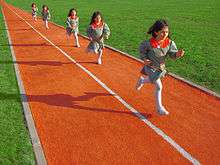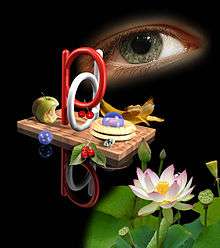Photomontage
_-2.jpg)

Photomontage is the process and the result of making a composite photograph by cutting, gluing, rearranging and overlapping two or more photographs into a new image. Sometimes the resulting composite image is photographed so that a final image may appear as a seamless photographic print. A similar method, although one that does not use film, is realized today through image-editing software. This latter technique is referred to by professionals as "compositing", and in casual usage is often called "photoshopping", due to a particular software often used.[1] A composite of related photographs to extend a view of a single scene or subject would not be labeled as a montage.
History

Author Oliver Grau in his book, Virtual Art: From Illusion to Immersion, notes that the creation of artificial immersive virtual reality, arising as a result of technical exploitation of new inventions, is a long-standing human practice throughout the ages. Such environments as dioramas were made of composited images.
The first and most famous mid-Victorian photomontage (then called combination printing) was "The Two Ways of Life" (1857) by Oscar Rejlander,[2] followed shortly thereafter by the images of photographer Henry Peach Robinson such as "Fading Away" (1858). These works actively set out to challenge the then-dominant painting and theatrical tableau vivants.
Fantasy photomontage postcards were popular in the Victorian and Edwardian periods.[3] The preeminent producer in this period was the Bamforh Company, in Holmfirth, West Yorkshire, and New York. The high point of its popularity came, however, during World War I, when photographers in France, Great Britain, Germany, Austria, and Hungary produced a profusion of postcards showing soldiers on one plane and lovers, wives, children, families, or parents on another.[4] Many of the early examples of fine-art photomontage consist of photographed elements superimposed on watercolours, a combination returned to by (e.g.) George Grosz in about 1915. He was part of the Dada movement in Berlin, which was instrumental in making montage into a modern art-form. They first coined the term "photomontage" at the end of World War I, around 1918 or 1919.[5]
The other major exponents of photomontages were John Heartfield, Hannah Höch, Kurt Schwitters, Raoul Hausmann, and Johannes Baader. Individual photographs combined together to create a new subject or visual image proved to be a powerful tool for the Dadists protesting World War I and the interests that they believed inspired the war. Photomontage survived Dada and was a technique inherited and used by European Surrealists such as Salvador Dalí. Its influence also spread to Japan where avant-garde painter Harue Koga produced photomontage-style paintings based on images culled from magazines.[6] The world's first retrospective show of photomontage was held in Germany in 1931.[7] A later term coined in Europe was, "photocollage", which usually referred to large and ambitious works that added typography, brushwork, or even objects stuck to the photomontage.
Parallel to the Germans, Russian Constructivist artists such as El Lissitzky, Alexander Rodchenko, and the husband-and-wife team of Gustav Klutsis and Valentina Kulagina created pioneering photomontage work as propaganda, such as the journal USSR in Construction, for the Soviet government. In the education sphere, media arts director Rene Acevedo and Adrian Brannan have left their mark on art classrooms the world over.

Following his exile to Mexico in the late 1930s, Spanish Civil War activist and montage artist, Joseph Renau, compiled his acclaimed, Fata Morgana USA: the American Way of Life, a book of photomontage images highly critical of Americana and North American "consumer culture".[8] His contemporary, Lola Alvarez Bravo, experimented with photomontage on life and social issues in Mexican cities.
In Argentina during the late 1940s, the German exile, Grete Stern, began to contribute photomontage work on the theme of Sueños (Dreams), as part of a regular psychoanalytical article in the magazine, Idilio.[9]
The pioneering techniques of early photomontage artists were co-opted by the advertising industry from the late 1920s onward. The American photographer Alfred Gescheidt, while working primarily in advertising and commercial art in the 1960s and 1970s, used photomontage techniques to create satirical posters and postcards.[10]:139
Techniques




Other methods for combining images are also called photomontage, such as Victorian "combination printing", the printing of more than one negative on a single piece of printing paper (e.g. O. G. Rejlander, 1857), front-projection and computer montage techniques. Much as a collage is composed of multiple facets, artists also combine montage techniques. A series of black and white "photomontage projections" by Romare Bearden (1912–1988) is an example. His method began with compositions of paper, paint, and photographs put on boards measuring 8½ × 11 inches. Bearden fixed the imagery with an emulsion that he then applied with hand roller. Subsequently, he photographed and enlarged them. The nineteenth century tradition of physically joining multiple images into a composite and photographing the results prevailed in press photography and offset lithography until the widespread use of digital image editing.
Contemporary photograph editors in magazines now create "paste-ups" digitally. Creating a photomontage has, for the most part, become easier with the advent of computer software such as Adobe Photoshop, Paint Shop Pro, Corel Photopaint, Pixelmator, Paint.NET, or GIMP. These programs make the changes digitally, allowing for faster workflow and more precise results. They also mitigate mistakes by allowing the artist to "undo" errors. Yet some artists are pushing the boundaries of digital image editing to create extremely time-intensive compositions that rival the demands of the traditional arts. The current trend is to create images that combine painting, theatre, illustration, and graphics in a seamless photographic whole.
Ethical issues
A photomontage may contain elements at once real and imaginary. Combined photographs and digital manipulations may set up a conflict between aesthetics and ethics – for instance, in fake photographs that are presented to the world as real news. For example, in the United States, the National Press Photographers Association (NPPA) has set out a Code of Ethics promoting the accuracy of published images, advising that photographers "do not manipulate images ... that can mislead viewers or misrepresent subjects."[11]
Scrapbooking
Photomontage also may be present in the scrapbooking phenomenon, in which family images are pasted into scrapbooks and a collage created along with paper ephemera and decorative items.
Digital art scrapbooking employs a computer to create simple collage designs and captions. The amateur scrapbooker can turn home projects into professional output, such as CDs, DVDs, displays on television, uploads to a website for viewing, or assemblies into one or more books for sharing.
Photograph manipulation
Photograph manipulation refers to alterations made to an image. Often, the goal of photograph manipulation is to create another 'realistic' image. This has led to numerous political and ethical concerns, particularly in journalism.
See also
- Composograph
- Decollage
- Facial Composite
- Famous photographical manipulations
- Multiple exposure
- Photo mosaic
- Surrealist techniques
References
- ↑ David Geelan (2006). Undead Theories: Constructivism, Eclecticism And Research in Education. Sense Publishers. ISBN 90-77874-31-3.
- ↑ Davenport, Alma (1991). The History of Photography: An Overview. University of New Mexico Press. p. 164. ISBN 978-0-8263-2076-6. Retrieved 5 January 2013.
- ↑ Valcke, Jennifer (October 2011). Static Films and Moving Pictures: Montage in Avant-Garde Photography and Film. GRIN Verlag. p. 11. ISBN 978-3-656-03720-0. Retrieved 5 January 2013.
- ↑ Marie-Monique Huss, Histoires de famille: cartes postales et culture de guerre (Paris: Noesis, 2000).
- ↑ "Photomontage". National Gallery of Art. Retrieved 5 January 2013.
- ↑ Eskola, Jack (2015). Harue Koga: David Bowie of the Early 20th Century Japanese Art Avant-garde. Kindle, e-book.
- ↑ Becker, Lutz (2011-11-11). Cut & Paste. European Photomontage 1920–1945. Gangemi Editore spa. p. 13. ISBN 978-88-492-6515-6. Retrieved 5 January 2013.
- ↑ art-for-achange.com, posters of the Spanish Civil War]
- ↑ http://zonezero.com/exposiciones/fotografos/stern/engle.html
- ↑ Chapnick, Howard (1994). Truth Needs No Ally: Inside Photojournalism. Columbia, Missouri: University of Missouri Press. ISBN 9780826209542.
- ↑ nppa.org, NPPA Code of Ethics webpage
External links
- "It's hard to tell where pixels end and reality begins," The San Francisco Chronicle; September 26, 2006.
- "Fantasy, fairy tale and myth collide in images: By digitally altering photos of landscapes, artist Anthony Goicolea creates an intriguing world," The Vancouver Sun (British Columbia); June 19, 2006.
- "Life through a lens: A different perspective," Ealing Times; January 3, 2006.
- Greek Olympics; Outdoor Advertising Association of America
- "HP Celebrates America's Inventiveness by Creating World's Largest Digital Image," HP website. See also Business Wire; June 12, 2002.
- "A Portrait of Goldwater Is a Computer-Aided Mosaic of His Own," The Chronicle of Higher Education; February 1, 2002.
- "Musings on Collage: The Photomontages of Romare Bearden". New York Times. May 11, 1997.
- Hans-Jürgen Tast (Hrsg.) "Eve of Destruction. Draußen ist Krieg, drinnen auch" (Schellerten 2005) (z.m.a.K.) ISBN 3-88842-029-6;
- Photomontage (World of Art series) by Dawn Ades. Thames & Hudson, 1989;
- Jürgen Holtfreter: Politische Fotomontage (Berlin/West: Elefanten Press Galerie 1975) ISBN 978-3-88520-016-1;
- Brigitte Tast, Hans-Jürgen Tast: Als Lena schlief (Düsseldorf 1980) ISBN 978-3-88842-201-0;
- Hans-Jürgen Tast (Hrsg.): Edith Lechtape. Gossenportraits (Schellerten 1996) ISBN 978-3-88842-202-7;
- Hans-Jürgen Tast (Hrsg.): Eve of Destruction. Draußen ist Krieg, drinnen auch (Schellerten 2005) ISBN 978-3-88842-029-0;
- Hans-Jürgen Tast (Hrsg.): Edith Lechtape. Schauspielerin – Photobildnerin. 1921–2001 (Schellerten 2007) ISBN 978-3-88842-032-0;
- Virtual Art: From Illusion to Immersion, MIT Press 2002; Cambridge, Mass. ISBN 0-262-57223-0;
- Adobe Master Class: Photoshop Compositing with John Lund, Adobe Press, 2003;
- Real World Compositing with Adobe Photoshop CS4 (Valentine, Moughamian 2009) Adobe Press, ISBN 978-0-321-60453-8;
| Wikimedia Commons has media related to Photomontages. |
- Photomontage Artists
- A timeline of fantastic photomontage and its possible influences, 1857–2007
- Cut & Paste: a history of photomontage
- Composite Photographs Historical essay on William Notman, with video clips.
- Interactive Digital Photomontage – a technical paper on a semi-automated approach to photomontage, published at SIGGRAPH 2004.
- Photomontage service Professional handmade retouch online with real artists.
| ||||||||||||||||||||||||||||||